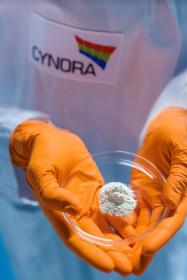German TADF developer Cynora presented its latest blue TADF material in May 2018 - with a CIEy of 0.14, EQE of 20% and a lifetime of 20 hours LT97 at 700 nits. Cynora expects to have blue material in the mass production by 2020.

Cynora's Chief Marketing Offer, Dr. Andreas Haldi was kind enough to answer a few questions we had regarding TADF emitters, the differences between next-generation emitter technologies, lifetime, color points and more.
Q: Dr. Haldi, thanks for agreeing to this short interview! Let's start. Cynora always discloses the lifetime of its materials at LT97. Can you explain why you choose LT97, how the lifetime graph usually works and whether we can extrapolate lifetime to lower levels of brightness (i.e. LT97 to LT95 ot LT70 or LT50)?
Lifetime is usually measured by applying a constant current to the OLED device and by monitoring the brightness over time. We then differentiate by how much decrease of the brightness we want to measure. A 3% decrease from the initial brightness (100%) is then called LT97, a 5% decrease is LT95 and so on. Lifetime curves follow a multi-exponential decay that can be extrapolated but the industry usually prefers the actual measurement to be on the safe side. But the exponential nature of the curve gives us some rough estimations: for example, LT97 is approximately half the lifetime of LT95.

Actual applications (displays or lighting panels) are usually specified by how long it takes until 80%, 70% or even 50% of the initial brightness are reached (LT80, LT70 and LT50, respectively). However, with today's quality of the OLED materials, such measurements just take too long in the development stage. Therefore, the typical lifetime measurement is rather done with LT97 or LT95. Historically, these lifetimes were also important since they define the burn-in time of the OLED displays. In the meantime, most OLED displays have additional compensation processes running, so that the LT97 of an OLED pixel does not correspond to LT97 of a panel anymore.
Q: We understand that the color point has a dramatic effect on lifetime, for example the move from 470nm blue to a deeper 460nm one. Can you help explain the mechanisms behind that?
That has to do with the energy of the light in an OLED device. The general rule in OLEDs is that the higher the energy of the light, the shorter the lifetime. That means that red has the longest lifetime, green is already shorter and blue is the shortest. This rule holds for fluorescence and for phosphorescence. For example, green phosphorescent pixels took longer to be implemented in OLED panels than their red counterpart since it was more difficult to reach customer specifications with the green lifetime.

What you can see on the large scale is also true for the small scale and the general rule also holds for just the blue spectrum: the deeper blue the color, the shorter the lifetime, generally. 5-10 years ago, this issue was observed and reported by fluorescent companies every now and then. Even some of most experienced blue fluorescent emitter developers were not able to avoid a lifetime drop of more than a factor 10 when reducing the wavelength by 10 to 15nm. Of course, those companies were later able to increase the lifetime for deep-blue again once they had found the lifetime limitation of those deep-blue emitters. This know-how helped them to compensate for some of the lifetime loss that had come with color.
At CYNORA, we were able to achieve the color (â¤0.16, ~460nm emission peak) and the efficiency requirement (>20% external quantum efficiency at 1,000 nits) at the end of last year. That was a huge achievement and it allowed us to fully focus on increasing the lifetime without having to worry about the effect of a further color change on the overall performance. In the meantime, we have been able to identify some of the issues for the shorter lifetime in deep-blue and we are now transferring this know-how into our next generation of emitter materials.
Q: How can we easily explain the difference terminology between nm color scale to CIEy?
Unfortunately, this is not a simple topic. In principle, for display panels, the CIE coordinates are the most important value since they define what color the user sees. The CIE coordinates can be calculated from an OLED spectrum and they depend on the peak emission wavelength but also the width and the shape of the spectrum. Just the peak emission unfortunately does not give enough information to judge the color of a device since a rather large range of colors can be achieved from a spectrum with only a fixed peak emission wavelength. One or two additional parameters are necessary to judge if a color is now suitable for displays or not. For blue, we usually focus on just the CIEy coordinate since the CIEx coordinate usually does not change much.
Q: In a similar way, brightness level also effects lifetime. Can you explain the difference for example between 500nits LT97 and 1000nits LT97?
The brightness and the lifetime usually show a linear behavior in a double-logarithmic plot. If we know the slope of this line, we can calculate/estimate the lifetime at different brightness. In a very rough estimation, the lifetime at 500 nits is approximately 3 times as long as the lifetime at 1,000 nits.
Q: There is a lot of talk about color purity / narrow spectrum. What is Cynora's take on that, and how does Fluorescence, Phosphorescence, TADF and HF systems compare?
Color purity or the narrow spectrum is important for a deep color. Color purity is partially fixed by the emission spectrum of the emitter but also by the architecture of the whole AMOLED panel (top-emission, color filters etc.). Generally, fluorescent emitters have rather narrow spectra while phosphorescent and TADF emitters have a broader emission. Hyperfluorescent uses fluorescent emission and therefore also shows this rather narrow emission spectrum.
However, we have to take into account that the width of the TADF emission spectrum depends also on the color. It is typically narrower for blue color and broader for the other colors. Therefore, the current width of our TADF emitters in deep-blue actually does not seem to cause a problem for our customers. But we also had a dedicated development last year to reduce this value.
Q: What is the current situation of TADF and hyperfluorescent blue?
With its focus on blue TADF emitters, CYNORA had reached the deep-blue color and the efficiency specifications for industrial applications at the end of last year. This allowed us to fully focus on lifetime and find the limitations of these TADF devices. We are now working on implementing our learning into new deep-blue emitters and devices to increase the lifetime towards the customer specifications.
Kyulux is working on hyperfluorescent OLEDs where TADF emitters are required to reach the high efficiency but the light is emitted from fluorescent materials. The company had historically focused more on green and yellow emitters, mostly also for PMOLED. A couple of weeks ago, Kyulux announced that they also have a skyblue hyperfluorescent system with high efficiency. According to their information, they seem to target deep-blue emission by next year.
The results from both companies cannot really be compared currently since Kyulux since the value of the efficiency and the lifetime only have a meaning once Kyulux has reached the deep-blue color. But the results show that TADF blue is edging closer to commercialization. This is a very important sign for the AMOLED industry where a high-efficiency blue emitter is very urgently needed to reduce the power consumption of these displays even further.
Q: Why is Cynora still confident that TADF blue can be good enough for production?
The lifetime of blue OLEDs has always been a challenge. Even for fluorescent emitters. But we now know that the lifetime of fluorescent blue emitters is good enough for current OLED displays. TADF emitters are only special fluorescent emitters, so there is no reason why they cannot be as stable as the current fluorescent blue emitters in production.
We are confident that our team of TADF experts will find the solution for our TADF materials to reach similar lifetimes as fluorescent emitters. Once we have reached a similar lifetime, we will be able to commercialize the first deep blue TADF emitter for commercial AMOLEDs.
Q: Are there any updates regarding Cynora's materials since SID 2018?
We have been able to define the limiting factors of our deep-blue TADF devices in the last half of the year and we are now implementing these learnings in our newest materials. I expect that we will give an update on our performance at the next conferences where we participate with talks, which are the SPIE Optics & Photonics in San Diego as well as IMID in Busan, Korea.
Comments
Sti - objectively speaking, I didn't see any "lashing out" - in fact I was impressed with how Andreas talks about Kyulux.
Mostly correct facts, but this one is too much sugar coating the harsh reality for my taste:
”But we now know that the lifetime of fluorescent blue emitters is good enough for current OLED displays. TADF emitters are only special fluorescent emitters, so there is no reason why they cannot be as stable as the current fluorescent blue emitters in production.”
This is wishful thinking - TADF is not just “special” fluorescence, the exciton lifetime is roughly 1000 times longer, which gives them the identical achilles heel phosphorescent emitters suffer from. As we all remember, both UDC and BASF started strong as well but had to give up the race because of these effects.
Not saying that TADF can’t be stable, but if the degradation causes by the long-living excited states is not mastered, it will not have a future.
Well, there is a certain framing - recently Kyulux themselves described their 470 nm as the best blue around, while Andreas as a representative of their fiercest competitor 1) calls the color skyblue (which frankly cannot be estimated from just the peak emission, unless they know more than has been published) and 2) claims that Kyulux’s admirable performance is “meaningless” (come on!) and 3) unnecessarily and falsely claiming that Kyulux is traditionally only focused on green and red (they started with blue even before Cynora did and were vocal about this until some years ago. Lastly, 4) the remark that they are doing mostly PMOLED is also a thinly veiled jab. It is clear AMOLED is a much bigger market, but why not doing it to generate revenues and train sales managers??Material-wise, this does not matter at all, the same materials could go straight into a display (ok, not the yellow stuff).
Most of the interview is the truth and hard facts, so sneaking in (naturall) biased assessments about competitors in an otherwise ”educational” interview is really blurring the lines too much and plain unfair in my opinion. Would love to read what Kyulux has to say about this.
sti


Looking forward to seeing these updates numbers - these conferences are only three weeks away.
Still strange approach and timing - if it’s only weeks, why are they lashing out against the competition now with nothing but claims and promises rather than wait until end of August to come with a much stronger, fact-based attack? Trying to appease or close any investors?
sti